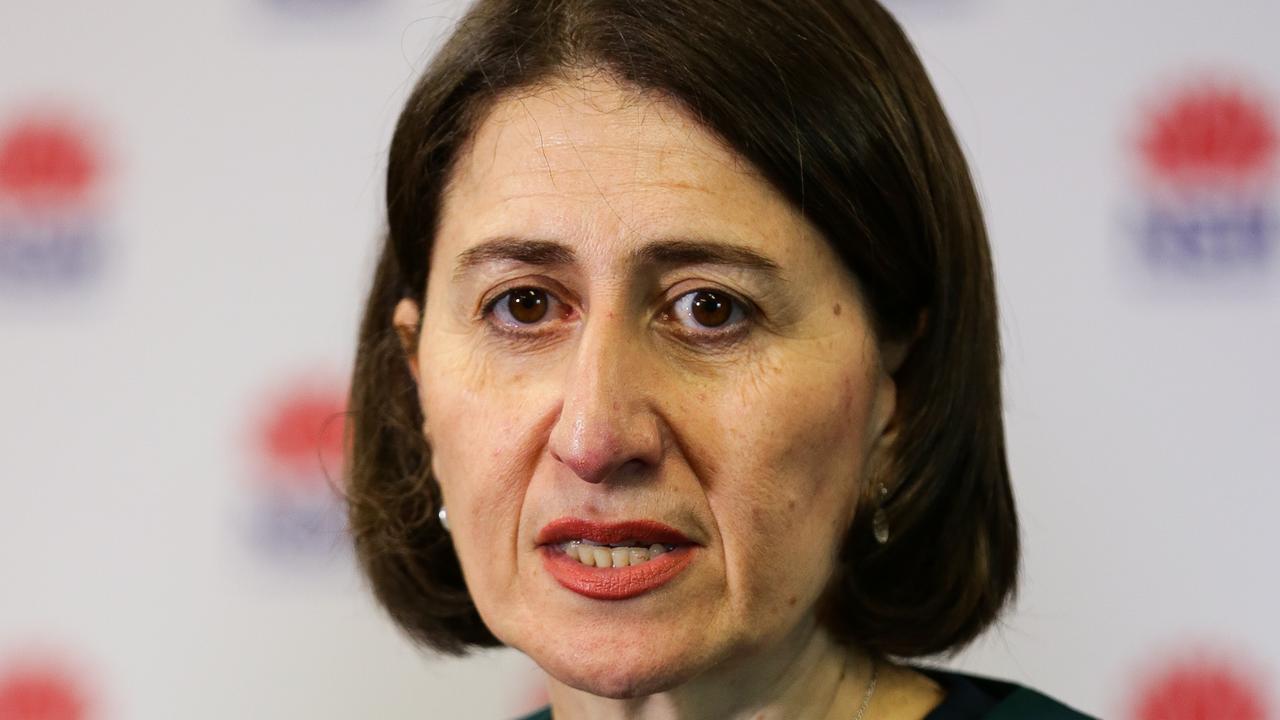Why authorities are reluctant to go into lockdown in NSW and don’t believe coronavirus can be eliminated
NSW is resisting calls for a second lockdown and says elimination of the coronavirus is impossible. This is why.

As the coronavirus continues to spread across NSW, authorities are resisting calls for a second lockdown and say it’s impossible to eliminate COVID-19.
Premier Gladys Berejiklian said she does not want to close the state down again despite the state recording more than 200 new coronavirus cases in the last month.
An outbreak at Sydney’s Crossroads Hotel in Casula has infected more than 40 people and seen more than 20 pubs, restaurants and other venues put on high alert.
“That’s not a path we want to take,” Ms Berejiklian said of lockdown, adding that the best way to manage the pandemic was through a suppression strategy.
“Unfortunately what we all have to accept is that as restrictions have eased and as people start to go back to work and to daily lives, we will see case numbers increase,” she told 7.30 on Tuesday.
The state seems intent on keeping businesses open and say residents should get used to outbreaks happening.
The Premier said NSW had quadrupled its health capacity, got protective equipment for frontline workers and had put processes in place to help contain the spread.
But why is NSW so reluctant to go back into lockdown?
THE PURPOSE OF LOCKDOWN
A lockdown would likely involve asking people to stay in their homes, closing many businesses and limiting restaurants to offering takeaway.
One of the reasons why NSW might go into lockdown is to give the state a better chance at eliminating the virus.
Every other state and territory except NSW and Victoria has achieved elimination and NSW got very close before Victoria’s outbreak saw cases migrating north.
Basically elimination involves stopping community transmission and getting active cases down to zero for at least two weeks.
Some experts believe it’s still possible for NSW and Victoria to do this but they say both states need to introduce tougher measures to have a chance of quashing the virus.
A lockdown in NSW may or may not be required, depending on how effective authorities have been in containing the spread of the virus.
But Premier Berejiklian said that elimination was not going to happen in NSW, pointing to the state’s population size.
“It’s not going to happen in New South Wales, it never will,” she said.
“We need to find a way in which we can coexist with the virus.”
‘THE CURE COULD BE WORSE’
One of the biggest problems with going into lockdown is the cost to businesses and the economy.
As Ms Berejiklian noted in her comments, business confidence takes a hit if they are constantly being forced to close.
“Every time we have an outbreak, we can’t afford to lockdown, reopen, lockdown, reopen,” she said. “That’s no way to live or to be able to instil confidence to businesses to keep employing people.”
RELATED: Victoria refuses to release key virus data
RELATED: Melbourne man identified as source of Crossroads Hotel cluster

Economist and modeller Professor Quentin Grafton of Australian National University said the cost of Australia’s six-week lockdown had been estimated at $50 billion and the cost of Victoria’s lockdown was estimated around $10 billion.
“Those are large amounts of money and you can see why premiers don’t want to make those calls,” he said.
But he said the paradox of lockdown was that if states were able to achieve elimination, the economic recovery is better than if there is still community transmission.
“If we don’t go for elimination of community transmission, then we get exactly what is happening right now, we get a rebound because this virus is highly contagious so if even there are low levels of virus it will come back as soon as we start to relax social distancing, it’s almost inevitable.”
However, Prime Minister Scott Morrison told Triple M on Wednesday that “you don’t just shut the whole country down because that is not sustainable”.
“I’ve heard that argument – you’d be doubling unemployment potentially and even worse, the cure would be worse, than what arguably wouldn’t be delivered anyway.”
AUSTRALIA WILL ALWAYS BE CONNECTED TO THE WORLD
One of the uncertainties of aiming for elimination is whether it’s a realistic goal.
During his interview, Mr Morrison pointed out that the outbreak in Victoria came from a breach in the state’s hotel quarantine system.
This is one of the great weaknesses of any elimination strategy because even if Australia manages to get rid of the virus within the country, it is still circulating in other parts of the world.
People with the virus will continue to enter Australia as the government can’t stop citizens who want to return home from coming back.
As Victoria’s example showed, it’s very difficult to make systems like hotel quarantine fullproof due to human nature.
Australia also relies on products that are shipped from overseas.
“Unless we’re going to not allow any freight, or any medical supplies into Australia, or not allow any exports or anything like this, there is always going to be a connection between Australia and the rest of the world,” Mr Morrison said.
Because of this, there would likely be small outbreaks even if Australia did succeed in eliminating the virus for a while.
Mr Morrison told reporters on Thursday that an elimination strategy would see “hundreds of thousands of more people unemployed”, businesses closing and livelihoods destroyed.
“You can’t mortgage off your economy for what would prove to be a very illusory goal, that’s certainly the health advice that I had and it’s certainly also the economic advice I have.”
YOUNG PEOPLE ARE THE MOST LIKELY TO GET IT
Infectious diseases physician, Professor Peter Collignon of the Australian National University, is sceptical that elimination is possible and believes authorities are taking the right approach in suppressing the virus, which may unintentionally lead to elimination as has been the case in other states and territories.
One crucial factor is the timing of restrictions, if authorities are aiming for elimination they may wait longer to ease lockdown or other measures to ensure there are no more cases still circulating in the community.
But Prof Collignon said one of the issues was the spread among young people.
“Young people in their 20s and 30s are the biggest group that have it and they have the mildest symptoms,” he told news.com.au.
“So we can’t be sure that it has been eliminated unless we went for about three months without seeing any cases because it could still be bubbling around under the surface if it is mainly being spread among young people.”
He said diseases like smallpox had been eradicated around the world and measles had been eliminated in Australia but this took years and was partly because a vaccine was available.
“The conditions for elimination are just not there," he said.
He said the term elimination was also problematic because it gave people a false sense of security, meaning they are less likely to maintain physical distancing and other measures.
“As soon as it comes back, you are in the same boat again,” he said.
RELATED: Australia’s yoyo future if COVID-19 is not eliminated

Prof Collignon said a lockdown may not be necessary as other measures could be just as effective in controlling the virus as a lockdown. He said around 700 people were infected on the Ruby Princess but they only passed on the virus to about 440 people even though they were not told to isolate until a day after they had already disembarked.
“This was achieved by people changing their behaviour,” Prof Collignon said.
He said studies of transport and other movement indicators showed people in most cities around the world had changed their behaviour 10 days or so before government restrictions were brought in.
“People’s behaviour can make a big difference without a total lockdown,” he said.
He said Victoria had the hardest lockdown in March and April compared to other states but hadn’t got the best result.
“There’s the possibility of overdoing restriction.”
BUT ELIMINATION IS POSSIBLE, EXPERTS SAY
Despite all the problems, some experts still believe Australia, including NSW and Victoria, can achieve elimination and are calling for authorities to embrace the strategy.
They say it may require a longer lockdown in Victoria with tougher restrictions, and a possible lockdown in NSW.
“It is absolutely possible,” Prof Grafton said. “You can see that from Western Australia, South Australia, Northern Territory, Tasmania and other countries like New Zealand.
“I'm not saying it’s easy – if we were talking about this in March it was reasonable to think that it wasn’t going to happen – but that’s not the case, the impossible has become possible, there’s no question around that.
“But are we prepared to undertake what’s necessary to bring about elimination?”
Prof Grafton said if low levels of the virus were allowed to continue circulating in Australia, there was a higher risk of “yoyo lockdowns” that would see businesses open up and then close again once authorities lost control of infections – like what’s happening in Victoria.
He said elimination should be the goal because the economic recovery would be better if the states succeeded and activities were able to resume to near normal levels.
“Look at New Zealand right now, they’ve got 45,000 people going to footy matches with no social distancing,” he said.
Prof Grafton said leakage of infection from places like hotel quarantine could be minimised by making changes.
“There are risks having cases staying in hotels in our largest cities where people can get out and meet lots of other people,” he said.
Prof Grafton said those in quarantine should also be tested for coronavirus on arrival and before they leave.
“There’s a complacency that people talk about among ordinary Australians and that’s certainly true but there’s also been complacency by authorities.”
He said testing and contact tracing needed to be improved.
“Victoria is well past its capacity to do contact tracing, with about 270 cases a day it was overwhelmed,” he said.
“There are testing sites in Sydney where people are waiting hours to get tested and waiting days for results.”
This is a problem given NSW authorities have said new cases are becoming infectious in as little as one day after contracting the virus.
“All test results should be available within 48 hours and contact tracing should be improved so authorities can manage up to 300 case numbers per day,” Prof Grafton said.
In NSW, Prof Grafton said authorities needed to be “nimble and quick” in ramping up restrictions if the actions they were taking did not seem effective.
“If it’s not working you have to expand and do it better. You have to be quick, you can’t wait weeks.”
Prof Grafton said there was no reason why NSW couldn’t eliminate the virus.
“But it can’t happen if the premiers in NSW, Victoria and the Prime Minister don’t make elimination a goal,” he said.
“If we put the resources in we can get elimination. If it’s not a goal then we aren’t going to get it.”




